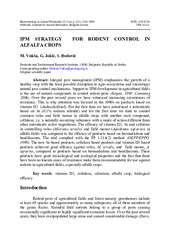Prikaz osnovnih podataka o dokumentu
IPM strategija zaštite lucerke od glodara
IPM strategy for rodent control in alfalfa crops
| dc.creator | Vukša, Marina | |
| dc.creator | Jokić, Goran | |
| dc.creator | Đedović, Suzana | |
| dc.date.accessioned | 2023-01-10T15:01:45Z | |
| dc.date.available | 2023-01-10T15:01:45Z | |
| dc.date.issued | 2009 | |
| dc.identifier.issn | 1450-9156 | |
| dc.identifier.uri | https://ripest.pesting.org.rs/handle/123456789/117 | |
| dc.description.abstract | Integralna zaštita bilja (IZB) podrazumeva uzgajanje zdravih biljaka sa što manjim narušavanjem ravnoteže agroekosistema i uvođenjem prirodnih mehanizama za kontrolu štetočina. Podršku razvoju IZB u poljoprivredi predstavlja uvođenje preparata na bazi prirodnih aktivnih materija za kontrolu glodara u polju. Poslednjih godina smo svedoci pojave rezistentnosti. Zbog toga je 90-tih godina razvijen rodenticid na bazi vitamina D3 (holekalciferol). Po prvi put, mi smo uveli rodenticide na bazi Se (0,1% Na selenita) i po prvi put smo pokušali da ih primenimo za suzbijanje voluharica i poljskih miševa u lucerki, kao i preparat na bazi prirodne supstance celuloze, čiji se mehanizam delovanja razlikuje od drugih aktivnih materija. Efikasnost preparata na bazi vitamina D3, Se i celuloze u suzbijanju poljske voluharice (Microtus arvalis) i poljskog miša (Apodemus agrarius) u lucerki poredili smo sa efikasnošću preparata na bazi bromadiolona i brodifakuma. Testovi su rađeni po metodi PP 1/114(2) (OEPP/EPPO,1999). | sr |
| dc.description.abstract | Integral pest management (IPM) emphasizes the growth of a healthy crop with the least possible disruption to agro-ecosystems and encourages natural pest control mechanisms. Support to IPM development in agricultural fields is the use of natural compounds to control rodent pests (Kogan, 1998; Cumming 2006). Over the past several years we have witnessed increasing occurrences of resistance. This is why attention was focused in the 1990s on products based on vitamin D3 (cholecalciferol). For the first time we have introduced a rodenticide based on Se (0.1% sodium selenite) and for the first time we tried to control common voles and field mouse in alfalfa crops with another such compound, cellulose, i.e. a naturally-occurring substance with a mode of action different from other rodenticide active ingredients. The efficacy of vitamin D3, Se and cellulose in controlling voles (Microtus arvalis) and field mouse (Apodemus agrarius) in alfalfa fields was compared to the efficacy of products based on bromadiolone and brodifacoum. The trial complied with the PP 1/114(2) method (OEPP/EPPO, 1999). The new Se-based products, cellulose based products and vitamin D3 based products achieved good efficacy against voles, M. arvalis, and field mouse, A. agrarius, compared to products based on bromadiolone and brodifacoum. These products have good toxicological and ecological properties and the fact that there have been no known cases of resistance make them recommendable for use against rodents in agricultural fields, especially alfalfa crops. | en |
| dc.publisher | Institut za stočarstvo, Beograd | |
| dc.rights | openAccess | |
| dc.rights.uri | https://creativecommons.org/licenses/by/4.0/ | |
| dc.source | Biotechnology in Animal Husbandry | |
| dc.subject | vitamin D3 | en |
| dc.subject | selenium | en |
| dc.subject | cellulose | en |
| dc.subject | biological efficacy | en |
| dc.subject | alfalfa crop | en |
| dc.title | IPM strategija zaštite lucerke od glodara | sr |
| dc.title | IPM strategy for rodent control in alfalfa crops | en |
| dc.type | article | |
| dc.rights.license | BY | |
| dc.citation.epage | 1248 | |
| dc.citation.issue | 5-6-2 | |
| dc.citation.other | 25(5-6-2): 1241-1248 | |
| dc.citation.rank | M51 | |
| dc.citation.spage | 1241 | |
| dc.citation.volume | 25 | |
| dc.identifier.fulltext | https://ripest.pesting.org.rs//bitstream/id/13/114.pdf | |
| dc.identifier.rcub | conv_153 | |
| dc.type.version | publishedVersion |

